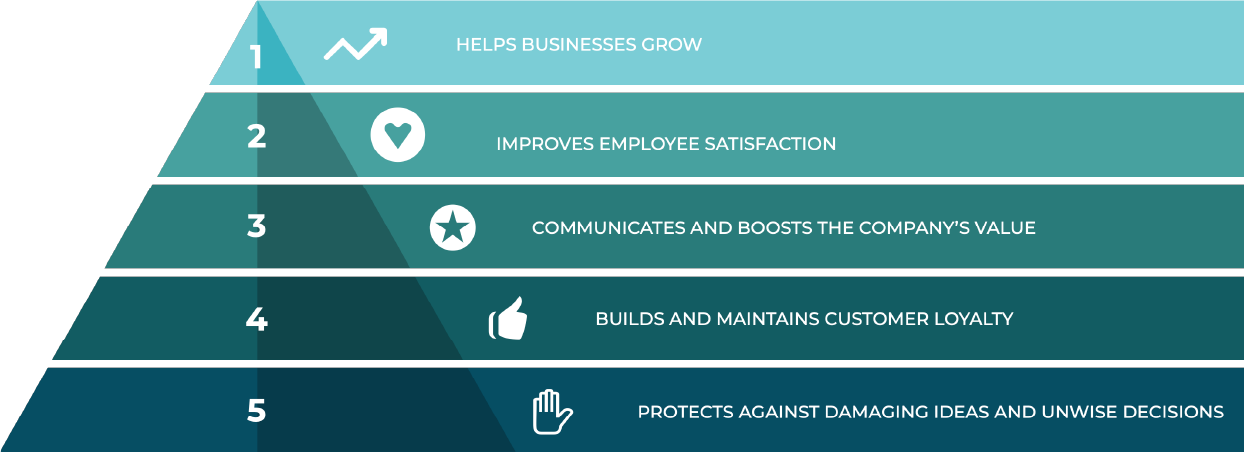Table Of Content
-
What is brand strategy?
-
What is the purpose of brand strategy?
-
-
Helps businesses grow:
-
Improves employee satisfaction:
-
Communicates and boosts the company’s value:
-
Builds and maintains customer loyalty:
-
Protects against damaging ideas and unwise decisions:
-
Just as any building doesn’t just pop into existence and requires a ton of architectural experience and planning to make it a reality, brands need structuring and strategy to work out. Although some businesses disregard its importance completely, brand strategy can be one of the companies either greatest assets or unfortunates.
Think of your brand, as we’ve just pointed out, as a building. The brand strategy is the design and operational blueprint of this building that establishes how it should look and perform and what branding and marketing initiatives are required to fulfil its vision.
What is brand strategy?
Brand strategy refers to the organisation’s meticulously crafted, inter-departmental plan covering every aspect of the niche, audience, and competition. The brand strategy typically includes the key competitive advantages, mission, vision, purpose, and goals; in an attempt to build rapport and favorability in the market and improve the consumer experience, growth, and competitive performance.
While building a comprehensive, on-spot brand strategy that is purpose-led and serves the brand’s best interest can be a headache (and it actually is), it’s unavoidable. In this article, we will walk you through the potential benefits of a compelling brand strategy and what it takes to build one.
What is the purpose of brand strategy?
A clear, all-around brand strategy paves the path for a better understanding of the brand core and value, keep everyone within the company on the same page, and creates a competitive awareness for the audience and employees alike.

1- Helps businesses grow:
The importance of any brand lies in its value.
As you might already know, businesses can profit or grow in several ways, one of which is to increase the perceived value of what they already have and offer. Brand value, in the simplest terms, is everything a company does that impacts the business’s bottom line.
The brand strategy revolves around that one simple concept, and it’s what you need to use in your favour as a business owner: to describe and define the brand in the light of what makes it exceptional amongst the competitors and how is it capable of making a difference in the consumer’s life. In sum, your brand strategy states what could be the reason for the brand to run still if it wasn’t for money and why it exists beyond making money and profiting, and only a smart brand strategy can clear this up.
The brand strategy helps everyone see the potential opportunities and value for the company, which creates a deep dimension to the brand. This way, it will be easier to do things differently in the market and attract the right prospects.
2- Improves employee satisfaction
If your company stands for a clear set of values, vision, and mission, it will naturally attract a workforce that embraces and shares the same beliefs. The employees will be more likely to understand and relate to the company’s philosophy, contribute positively, and feel they are having and working for a meaningful mutual purpose.
3- Communicates and boosts the company’s value:
Consumers don’t really put money in objects as much as they do in value or meaning. Even if a clear value didn’t drive the initial purchases, consumers tend to add one to them later.
The harsh truth is that even if you provide the perfect package, people would not still choose you for what you do solely; they, on the contrary, will buy why you do it and what makes it so unique and valuable to them.
In putting together the pieces of your brand strategy, you need to dive into the depth of your offerings and outline how they can impact your customers’ lives and how they differ from what your competitors do. This way, you will soon get ahead of your competitors, not by anything but simply being you.
4- Builds and Maintains Customer Loyalty:
Speaking of value, the purchase decision is ultimately driven by an emotional connection. It’s said that people don’t buy products; they buy brands. In that light, the brand strategy helps you create a human connection with the target people that grow them emotionally and mentally attached to your brand. It all comes down to the value they see and perceive from your brand, which makes it hard for them to ditch or replace it.
By fully understanding the audience preference and building the entire brand around it, boosting strengths and eliminating weaknesses, people would eventually come to notice and appreciate the efforts, therefore gravitate towards the brand, advocate for it, and endorse it to their close circles.
5- protects against damaging ideas and unwise decisions
When you have all the elements of your brand clearly laid out in one place, including the target audience and market, competition, objectives, weaknesses, strengths, opportunities, and risks, it will become unlikely to get distracted or astray from your long-term vision and pre-defined goals.
Even if you are faced with some challenges or crossroads down the road or maybe have fallen into some hassle, you would always have a clear roadmap to refer back to in order to reorganise your operations and initiatives, filter out ill-advised decisions, and make more well-judged ones in alignment with that end-vision
7 core elements of a brand strategy
The brand strategy is the booklet of everything about a brand that can benefit every department in the company, from marketers and designers to executive staff.
Here are the core elements of a brand strategy that you need to take time defining:
Purpose
A brand purpose is what defines the motive behind running this business. Purpose can have two faces, one focuses on generating materialistic and commercial profits, and the other focuses on delivering value and good impact beyond just profitability.
Promise
Brand promise refers to what the audience can (or should) expect from the company. It should, however, be backed with the ability and constituency to deliver that promise every single time at any given occasion.
Brand Vision
Brand vision serves as a detailed roadmap that ensures the company is headed towards the right destination. A clear vision can help make informed business decisions and motivate the team.
Brand Values
Brand values are the set of core beliefs that determines the brand culture and philosophy. By setting and embracing powerful brand values companies will gain an edge on their competitors, maintain consistency, and portray the company in a professional and cohesive fashion.
Target Audience
In making your brand strategy, it’s vital to understand your target audience, their nature, problems, and preferences if you want to reach and have the greatest influence on them. Understanding your target audience will ensure full alignment between your values and theirs and allow you to be flexible in the face of any change in the market trends or audience behavior, therefore, crafting the right messaging that hits the right spot in their hearts and minds.
Market Analysis
Having a complete understanding of the market scene will help you spot the unfilled gap and use it in your favor. Market analysis will assist in defining what differentiates you from the rest and what opportunities you can unlock to be ahead of the competition.
Brand Voice
Defining a clear tone of voice to your brand will help your audience identify and recognize you from the crowd.
When you have all the elements of your brand clearly laid out in one place, including the target audience and market, competition, objectives, weaknesses, strengths, opportunities, and risks, it will become unlikely to get distracted or astray from your long-term vision and pre-defined goals.
Even if you are faced with some challenges or crossroads down the road or maybe have fallen into some hassle, you would always have a clear roadmap to refer back to in order to reorganise your operations and initiatives, filter out ill-advised decisions, and make more well-judged ones in alignment with that end-vision
Grow Your Knowledge
Join thousands of other business professionals. Keep up-to-date with the latest branding blogs, marketing and personal branding from Logo Talks experts. Don't miss out!


